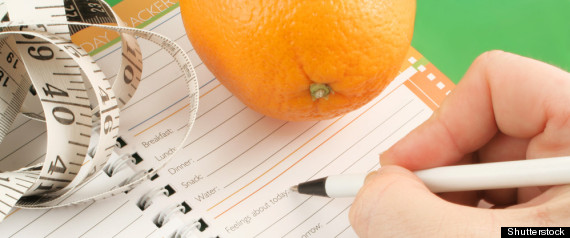If you're anything like me, you have no idea how much food you inhale on a day-to-day basis. Thanks to multitasking, grabbing grub on the go, parking myself in front of the TV while munching, and various other weight-loss crimes, I often barely register that I'm eating. Take last week: I was totally oblivious that I was popping jelly beans into mymouth until my nephew complained that I was about to polish off his bag (sorry again, Jake). It's tough to watch every mouthful you eat, even if you're an expert. Researchers at Louisiana State University asked dietitians to estimate their daily caloric intake — and even the professionals lowballed the number by 10 percent. That may explain why it's so hard to shed pounds, no matter how good the plan is.
But there's a simple solution: Keep a food diary. Studies show that a journal doesn't just aid weight loss — it turbo-charges it. When researchers from Kaiser Permanente Center for Health Research followed more than 2,000 dieters who were encouraged to record meals and snacks, they found that the single best predictor of whether a participant would drop weight was whether the person kept a food diary. It trumped exercise habits, age, and body mass index. The number of pounds people lost was directly related to the number of days they wrote in their log. (It's no coincidence that Weight Watchers, one of the most successful diet programs, asks participants to track what they eat.)
Here are five more reasons to start a journal today — even if you swore off diaries in middle school.
1. You'll get a reality check about how many
calories you consume.
Americans typically underestimate their daily intake by about 25 percent, reports nutritionist Carrie Latt Wiatt, author ofPortion Savvy. The situation gets even more complicated when you eat out. In a 2006 study led by Cornell University, 105 diners in fast-food restaurants were asked how many calories were in their orders. For the small items, almost everyone guessed correctly; for the larger orders, the diners underestimated the calories by a whopping 38 percent. It may be an issue of perception, says study author Brian Wansink, Ph.D. The larger the quantity, the harder it is to make an accurate guess — the same is true for distances and heights.
Even professionals can be tricked by hefty portion sizes. When an NYU researcher asked 200 dietitians to estimate the calorie count of four popular restaurant dishes, the experts lowballed the number for each by a whopping 250 to 700 calories.
So stop assuming and start calculating. A good manual, like the classic Calorie King Fat & Carbohydrate Counter, makes it easy by giving you the calorie counts and fat grams for a huge number of foods. Or try nutritiondata.com, which also lists the stats for many foods.
2. You'll cut back on
between-meal munching.
Make a mental checklist of what you ate yesterday. Sure, you can probably rememberbreakfast, lunch, and dinner — but what about that mini Snickers you snatched from your coworker's stash? Or that spoonful of mashed potatoes you took off your husband's plate?
It's easy to overlook bites, licks, and tastes (known as "BLTs" to professionals). But that's a huge mistake — there are 25 calories, on average, in each mouthful. Translation: Six little bites a day add up to around 15 extra pounds a year.
"I remember one client who was keeping a diary and couldn't understand why she wasn't losing weight," says Bethany Thayer, R.D., spokesperson for the American Dietetic Association. "We were discussing the problem when she took out a peppermint. I asked her how many she ate every day, and she said, ‘A bag.' They're nine calories each, but the whole bag is several hundred."
Writing everything down can also help you make smarter food choices. If you often order a Starbucks Grande Dulce de Leche Latte, entering the data will bring you face-to-face with the fact that your beloved drink packs 440 calories, versus 23 calories for the same-size regular coffee with milk.
3. You'll discover where
your diet detours.
"I thought I ate a lot of vegetables — it seemed like I was constantly cooking spinach, broccoli, or Brussels sprouts," says Melissa Smith, a 32-year-old mom from Omaha who's been keeping a food diary for the past 18 months. "But looking back over a few weeks of my journal, I was surprised to realize that I was only eating veggies once or twice a week." So she made salads a regular part of dinner and noticed that it helped her eat less of her entrée. Her analysis and follow-up action paid off: She's lost more than 27 pounds.
A balanced diet is the key to weight loss, says Suzanne Farrell, R.D., who owns Cherry Creek Nutrition in Denver. "Whole grains, low-fat dairy, green vegetables, orange veggies, beans, nuts — science shows that we need to eat these regularly to reach a healthy body weight. So when I flip through my clients' journals, I always look for what I'm not seeing."
To find out how many servings of each food group you should be eating, go to mypyramid.gov. This tool will calculate the correct portions based on your age, gender, height, weight, and level of physical activity. It'll also tell you the number of calories you should aim for daily to lose weight.
4. You'll learn why you
pig out.
Experts suggest that, to help break bad habits, you record not only what you eat, but the circumstances that prompt you to eat. For example, maybe you indulge in more sweets at work because you sit close to the vending machine. Maybe you have a milkshake several times a week because you pass Wendy's on the way home. Or maybe every time you worry about money, you retreat into the kitchen for chips.
When you begin to notice these patterns, you can figure out ways to change them. If the vending machine is a constant temptation, stock your desk drawers with fruit and granola bars. If you can't resist a fast-food sign, MapQuest a new route to work. If you eat when you're under pressure, steer clear of snacks and take a short walk instead (it's a scientifically proven stress buster).
Another bonus: "When you increase awareness of what's going into your mouth," says Thayer, "you'll feel fuller sooner than if you were just mindlessly munching."
5. You'll see real results —
quickly.
Your food diary can be as revealing as the one you kept in fifth grade. For example, to get a glimpse into how much you've improved your diet, compare the entries in week one (Twinkie-filled) to week four or five (ideally, veggie-filled). You can also discover which decisions translated into pounds lost — for instance, that week you had fish for dinner twice might've helped you lose weight.
Food journals also let you give yourself credit where credit is due (personally, I reward myself with a gold star each day I resist eating candy). And that positive reinforcement is essential for shedding pounds.
How to Write Off Pounds: A Cheat
Sheet to Get Your Food Diary Started
Choose Your Medium
If you're using pen and paper, buy a regular spiral notebook. Or go for a pre-organized book like the DietMinder. Computer addicts should check out online journals, such as myfooddiary.com ($9 per month) and nutrihand.com (free for a basic plan; $10 per month for extras). If you can't live without your PDA, visit weightbydate.com and download the software (starting at $19).
Start Recording
The crucial info to write down: the time you ate, what you ate, and how much you ate. Make a habit of jotting notes right after you eat. "If you wait until the end of the day, it's too easy to leave things out," warns Suzanne Farrell, R.D. Tracking your diet online? Remember to take paper with you to restaurants, so you can write down every ingredient and calculate its nutritional content afterward.
You may also want to invest in measuring cups — they'll help you learn what a one-and-a-half-cup portion looks like (it's a lot less than you think) — as well as a calorie-counter book and a calculator. Armed with these tools, you can track your calories like a nutritionist would.
Get Personal
Customize your diary so it reflects the info that's most useful to you. For example, if you're someone who eats whenever food is in front of you, create columns in your journal to rate how hungry you were before and afterward. If you snack your way through hard days, add a column to describe how you were feeling when you ate. Trying to figure out when you're most drawn to junk food? Record where you were when you indulged and what was going on at the time. Also, if you're trying to break a specific habit, like scarfing down ice cream at night, create a column for that, so you can give yourself a star for each day you resist the urge.
Be Honest
Include every single bite, lick, and taste (anything larger than a crumb counts). And don't forget to keep track of your sips. Even the most diligent diarists often forget to include the glass of white wine they had at dinner (120 calories) and their 3 p.m. can of Coke (155 calories).
Find Your Favorites
Counting calories is easier for creatures of habit: If you have a bowl of cereal forbreakfast almost every morning or a turkey sandwich three times a week, you won't have to look up the number each time.
Keep Your Diary Close
"I'm forgetful, so I always need to put the journal where I can see it — on my kitchen table, on my desk at work. I carry it a lot in my hand, too, as a reminder," says Melissa Smith, 32, of Omaha, who lost 25 pounds keeping a food diary.
You can also try this trick from Maryellen Mealey, 42, of Chicago, who lost big (188 pounds) keeping a journal: "I made a deal with myself that I wouldn't eat anything unless I wrote it down first. It's obsessive, but I'm a mindless snacker and putting everything in the book really helped me be more conscious," she says.
Examine the Evidence
No matter how diligent you are, a food log won't help in the behavior-changing department if you don't analyze it. At night, sit down and calculate how many calories you consumed. Tally up what food groups you're eating, and make adjustments. (A big plus of online tools is that they do a lot of the analysis for you, totaling everything with a click of a button and often giving you charts to show what you can improve.)
You may also want to consult a registered dietitian. A professional may see things in your diary that you don't (cost: usually $50 to $300 for an initial consultation). A two-year study from Fred Hutchinson Cancer Research Center in Seattle showed that participants who consulted a dietitian had better success keeping off weight than those who followed their usual diet.
Reward Yourself
"I read that it takes 28 days to build a habit," says Mealey. "So when I have a new goal — like eating veggies more often — I do it for a month, then treat myself by shopping or going to a movie with a friend. Rewards give me an incentive to keep going."
Source
http://www.webmd.com/diet/obesity/single-best-way-lose-weight












No comments:
Post a Comment